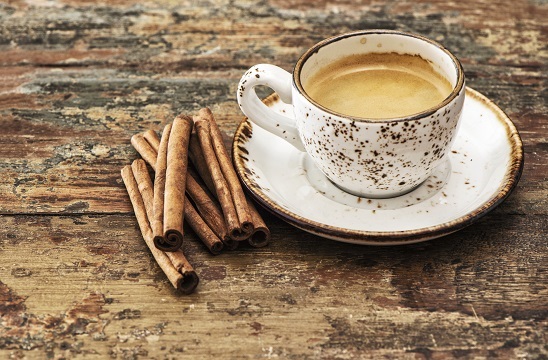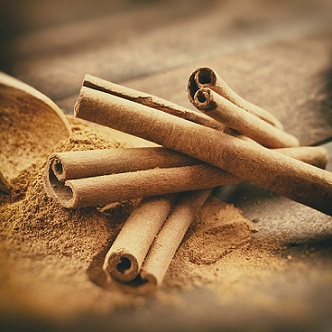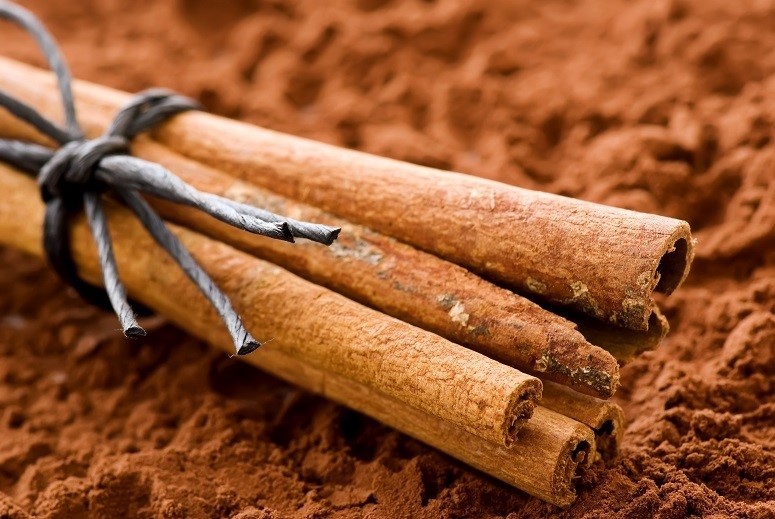 For years now, using cinnamon topically has been one of the top underground acne remedies.
For years now, using cinnamon topically has been one of the top underground acne remedies.
Cinnamon is widely recommended in combination with honey or yoghurt in a face mask for clearing acne. It’s most commonly favoured as a topical hyperpigmentation remedy, for getting rid of old acne scars or lightening and brightening your skin tone.
For decades, highly motivated acne patients have spread cinnamon powder onto their face because of faith, word of mouth, and a drive to experiment.
But after all these years, science has finally stepped in and made cinnamon’s acne powers official. Cinnamon has finally stopped being just a home remedy and entered another league.
In this article we covered why eating cinnamon can clear acne; it’s proven to lower blood sugar and insulin, and hence oily skin. But when applied directly to your face, the cinnamon spice has a very different set of powers.
Is topical cinnamon and its many associated skincare recipes proven to clear acne? Not quite, but keep reading and you’ll see just how promising the evidence is.
Topical cinnamon can improve skin tone
 The most interesting thing about the cinnamon spice is its complete unpredictability. If you’re reasonably knowledgeable about acne, you might know that ground cinnamon is one of the richest foods in antioxidants on earth, far richer than raspberries or blueberries. You might suspect that the antioxidants can strengthen your skin cells against free radicals, and indeed they can.
The most interesting thing about the cinnamon spice is its complete unpredictability. If you’re reasonably knowledgeable about acne, you might know that ground cinnamon is one of the richest foods in antioxidants on earth, far richer than raspberries or blueberries. You might suspect that the antioxidants can strengthen your skin cells against free radicals, and indeed they can.
But the best study performed on the spice to date revealed that cinnamon can enhance and increase the formation of collagen proteins when applied to the skin topically.
The study started when a gang of scientists searched for a substance in food which could revive stagnant collagen synthesis which had declined with age, in order to delay the physical symptoms of ageing. They quickly discovered that cinnamon extract increased the biosynthesis of collagen when applied to the skin.
Read Annihilate Your Acne – get the greatest diet ever for clear and radiant skin
The extract upregulated the protein expression of type 1 collagen, the main form used for the construction of new tissue in wound repair and for maintaining the skin’s structure (type 2 is found in joint cartilage). They identified the specific compound in cinnamon responsible – cinnamaldehyde. This substance promoted the activity of collagen by increasing the potency of insulin-like growth factor 1 (IGF-1).
The conclusion: “these results suggested that cinnamon extract is useful in antiaging treatment of skin”.
In other words, topical cinnamon may be a miracle substance for skin tone, appearance, and skin defence. Who would have suspected it? The specific compound cinnamaldehyde is responsible for the cinnamon spice’s distinctive taste and aroma. 0.5%-1% of cinnamon is the aromatic cinnamon oil; cinnamaldehyde comprises roughly 65% of that oil. It’s the main bioactive component in cinnamon.
IGF-1, meanwhile, is a growth hormone found in cow and human milk, designed to grow babies into adults at astonishing speed. However, it’s been proven in many studies to accelerate type 1 collagen formation as well, by controlling various proteins and genes.
Increasing blood levels of IGF-1 to in turn increase collagen production is a very foolish idea; IGF-1 increases sebum production by enhancing the sensitivity of insulin receptor cells to insulin. That’s one reason why milk can cause acne. However, there’s far less danger with locally enhancing IGF-1 on the skin’s surface through natural topical treatments, and somehow cinnamaldehyde can do that.
Furthermore, the study examined the cinnamon extract as a whole, not just the isolated cinnamaldehyde, so we know that concentrations of the compound in your average grocery store spice are high enough to actually have an effect.
This is easily one of the most surprising yet interesting studies for acne I’ve seen for a while.
Cinnamon ends hyperpigmentation – completely true after all
The skin tone enriching benefits don’t end there, because the theory that cinnamon can lighten the skin’s colour is also true. Cinnamaldehyde has recently become known for its antityrosinase activity.
Tyrosinase is one of the main players in hyperpigmentation. It’s an enzyme used to manufacture the skin pigment melanin, through conversion from the non-essential dietary amino acid tyrosine. Tyrosinase levels can explain human skin colour in general; melanocytes derived from black skin contain up to 10 times more tyrosinase activity. A mutation in the tyrosinase gene is one reason why albinos exist.
You need some tyrosinase, but, for acne and skin, excessive levels in localised spots are behind many cases of uneven skin tone. Sunlight can oxidise tyrosine and transform it into tyrosinase – that’s why a life spent outdoors can give you the pigmented, weathered look, like an ancient professional golfer.
To get great skin you need to keep tyrosine under control, and promisingly for cinnamon, cinnamaldehyde can do that.
One study found that cinnamaldehyde extracted from cinnamon essential oil had strong antityrosinase properties. Interestingly, another cinnamon compound called cis-2-methoxycinnamic acid had no effect on tyrosinase. The scientists concluded that cinnamaldehyde and cinnamon “possess potent anti-tyrosinase activities and may be a good source for skin-whitening agents”.
Next: the 6 vitamins and minerals which can massively reduce acne
Meanwhile, this study found that the whole essential oil of cinnamon was able to inhibit tyrosinase strongly. 19 compounds were detected in the oil; cinnamaldehyde represented 77.1% of the total, but beta-caryophyllene (6.0%), alpha-terpineol (4.4%), and eugenol (3.0%) were also detected.
The extract “showed antityrosinase activity” and was able to reduce the formation of insoluble flakes of melanin, AKA, the hyperpigmentation itself. The effect was mostly attributed to the cinnamaldehyde and the eugenol.
People have been speculating for years that applying cinnamon topically can lighten the skin. Well, it turns out that the home acne remedy mob was correct all along.
Make no mistake that this doesn’t always happen. The lemon juice crew claimed that it could soothe the skin; the acidity and psolaren compounds mean that the opposite is true.
With cinnamon, however, a real skin-enriching power was being observed in practise, for decades before the studies rolled in. This proves that hard data isn’t the be all and end all for acne.
If you notice benefits from a random topical treatment, whether it’s pomegranate juice or a banana peel, stick to it! Don’t let some mumbling science guru deter you.
Does topical cinnamon clear acne?
 For acne specifically, you have the vast count of antioxidants. The cinnamon spice ranks as number 3 in the list of antioxidant rich foods on the ORAC scale, scoring 267,536 next to ginger with 28,811 or blueberries with 6,552.
For acne specifically, you have the vast count of antioxidants. The cinnamon spice ranks as number 3 in the list of antioxidant rich foods on the ORAC scale, scoring 267,536 next to ginger with 28,811 or blueberries with 6,552.
In this study on 26 different herbs and spices, Ceylon cinnamon (the best type) beat a strong field containing garlic and oregano to be declared the richest food in antioxidants.
Cinnamaldehyde is one of the specific antioxidants found in cinnamon. In one study it was found to be more potent at scavenging free radicals than vitamin E. Other antioxidant compounds in cinnamon include styrene, cinnamic acid, cinnamate, procyanidins and catechins.
How do the antioxidants in cinnamon benefit acne? Applying antioxidants to your face keeps the cells strong against free radicals, and all the inflammation and clogged pores which come with them.
The most promising study directly related to acne was this one on cinnamon’s antibacterial effects. Two dried inner bark extracts of cinnamon were tested against p.acnes bacteria; the alcohol dried cinnamon extract had significant inhibitory activity. The power was attributed to the cinnamaldehyde and eugenol. Hence, the study concluded that cinnamon extracts could be used to develop new formulations for acne treatment.
This is only one study, but cinnamon is well known for its antibacterial activity. Its might be used to flavour cakes and biscuits but another purpose of using cinnamon as an ingredient is to prevent spoilage.
Cinnamon specialises in enriching skin tone, but is promising as a natural topical treatment for acne as well.
Cinnamon has no known side effects
Judging by all the data around, applying cinnamon topically also seems very safe for acne. For example, the other famous spice for acne is turmeric. With topical turmeric there was a long controversy about its photosensitising properties, since a few studies observed increased irritation of the skin from UV radiation after applying it.
Out of the already tiny 515 side effects reported to the American FDA after consuming cinnamon, only 2 involved photosensitisation. It’s possible that applying cinnamon directly damages your defences, but there’s no evidence.
Secondly, the one compound in cinnamon which might well irritate the skin can be circumvented easily.
The compound is coumarin, a plant toxin which cinnamon contains huge quantities of. Coumarin has been shown to cause liver damage when eaten in high amounts. It sounds like a risk, but here’s the truth – only “bastard cinnamon” contains coumarin. Specifically, cassia cinnamon, a spice derived from the Cinnamomum cassia plant from China.
The 7 greatest topical treatments for naturally clear skin
Cassia cinnamon is the common form you’ll find in a grocery store, but it isn’t true cinnamon. The real cinnamon is Ceylon cinnamon, from India and Sri Lanka. Ceylon cinnamon contains next to no coumarin. Furthermore, applying coumarin topically is a different story to eating it; it seems to have anti-inflammatory properties when it comes into contact with human skin.
Cinnamon might have hidden toxins or dangers which we don’t know about yet, but no big threats have been identified.
Your acne-friendly cinnamon recipe guide
If you do decide to use topical cinnamon for acne then you won’t be short for ideas. The internet is bursting with tons of recipes ranging from combinations with honey to apple cider vinegar. But few are formulated using science and logic; the creators seem to just throw popular skincare ingredients together. Some might work, others might fail.
Therefore, here are some cinnamon recipes for acne which are completely based on science:
Cinnamon and royal jelly – if you don’t know what royal jelly is, then it’s a nutritious food secreted by the glands of worker bees to grow the queen bee into a size twenty times larger than the average bee, which happens to an excellent acne treatment.
Royal jelly is rich in vitamins, minerals, growth factors, peptides, and antioxidants, all to feed the queen bee, and it happens that at least one of them can increase collagen output through some mechanism.
Combine royal jelly with cinnamon and you will have a double whammy of skin strengthening power. Royal jelly’s main claim to fame for acne is its antibacterial compounds (to keep the queen’s food from spoiling); these will add to the cinnamaldehyde’s ability to kill p.acnes bacteria. The recipe is very simple, since the powder and the jelly combine easily.
Cinnamon and egg whites – the other day I criticised the egg white mask as a home acne remedy, specifically because egg whites lack any substances which can improve acne significantly. However, egg whites do contain the enzyme lysozyme, a very powerful skin whitener.
Lysozyme works in the same way as cinnamaldehyde, by inhibiting the tyrosinase enzyme (study). Combine cinnamon with egg whites and you might create an extra potent hyperpigmentation treatment. Perhaps you have a particularly stubborn patch of dark skin; if that’s the case then this combination could be the solution. This recipe works best as a localised, targeted treatment rather than a whole face mask.
Cinnamon and cold pressed grapeseed oil – the benefit of grapeseed oil is that it’s an oil with strong moisturising abilities and a low propensity to clog pores. Since cinnamon is highly effective at strengthening the skin and lightening its tone, we might as well finish the job off with some moisturising and hydration.
This recipe is dead easy to use, just add some cinnamon to your grapeseed oil to thicken it into an easy to apply paste. Grapeseed oil will clear acne as well, due to its high vitamin E content.
Cinnamon and aloe vera – the gel of the aloe plant leaf also has the ability to stimulate collagen production, due to two plant-based growth hormones called glucomannan and gibberellin. While royal jelly inhibits bacteria effectively, aloe vera is high in antioxidants and has strong anti-inflammatory properties. You have two very different choices for taking the collagen enhancement of cinnamon through the roof.
Aloe vera was also shown in this study to enhance the acne-clearing powers of prescription retinoids massively; the combination beat the isolated retinoids with ease. If you buy Aubrey Organics Pure Aloe Vera Gel, then combining the two is simple, like with grapeseed oil.
Conclusion
Without any previous evidence to suggest it, it turns out that cinnamon is an effective topical acne treatment for increasing collagen production. Hence, cinnamon can strengthen your skin, and maybe even delay ageing if you religiously apply it day after day.
Cinnamon can also reverse hyperpigmentation, confirming the long held suspicions. Overall, cinnamon is a home skincare remedy which does work. Most of its powers to enrich the skin are down to the aromatic oil compound cinnamaldehyde.
The most interesting aspect of this story is the prospects for other household items. What unknown acne powers and compounds lurk in other foods? An increasingly popular strategy for acne is rubbing a banana peel all over your face. Maybe the inside of the peel contains a compound soon to be named “bananarol”, which downregulates sebum production. It’s highly unlikely, but the point is that there could be countless foods out there which could clear acne.
Nobody knew that cinnamon could delay ageing before this study came out. The reverse is true as well; innocently applying an apple slice to your face to clear acne might have some catastrophic consequences which we’re unaware of.
So remember – always keep your eyes open for fresh information and strategies.
NEXT: the ultimate diet for clearing acne permanently
Thanks for reading!